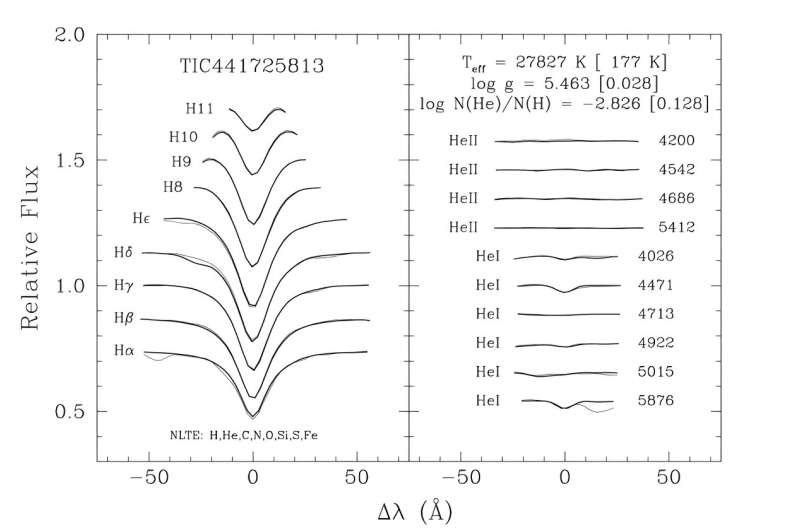August 1, 2024 report
This article has been reviewed according to Science X's editorial process and policies. Editors have highlighted the following attributes while ensuring the content's credibility:
fact-checked
preprint
trusted source
proofread
TIC 441725813 is a hybrid pulsating subdwarf star, study finds

Astronomers have employed NASA's Transiting Exoplanet Survey Satellite (TESS) to observe a subdwarf star designated TIC 441725813. In result, they found that TIC 441725813 is a hybrid hot B subdwarf pulsator. The discovery was detailed in a research paper published July 25 on the pre-print server arXiv.
In general, hot subdwarf B (sdB) stars are extreme horizontal branch objects composed of helium burning cores and very thin hydrogen envelopes. They are compact objects, typically about half as massive as the sun, with radii between 0.1 and 0.3 solar radii and effective temperatures ranging from 20,000 to 40,000 K.
Astronomers are especially interested in finding and characterizing pulsating subdwarf B (sdBV) stars, which showcase two types of flux variation. The first is associated with short period pressure modes (p-modes) with pulsation periods of the order of minutes and amplitudes of pulsation modes reaching tens of mmag. The second is due to long-period gravity modes (g-modes) exhibiting pulsation periods of the order of hours and amplitudes of pulsation modes below 10 mmag.
TIC 441725813, also known as TYC 4427-1021-1, is one of the brightest sdB stars so far detected. Previous observations have found that it has an effective temperature of 27,200 K and suggested that it is likely a short-period spectroscopic binary.
Now, a team of astronomers led by Wenchao Su of the University of Toulouse in France, have performed photometric observations of TIC 441725813 using TESS, which allowed them to get more insights into the nature of this star.
Detailed analysis of TESS light curves of TIC 441725813 allowed Su's team to identify a rich spectrum of features. In particular, they detected low to high frequencies, the possible orbital signature of a companion, a furnished g-mode pulsation spectrum with signatures of rotational splitting, and a few p-modes also showing the signature of rotation.
Furthermore, from the measured frequency splittings of the two types of modes in TIC 441725813, the astronomers estimated the rotation periods of both the core and the outer envelope. The core rotates very slowly with a period of at least 85.3 days, while the rotation period of the outer envelope is approximately 17.9 days.
According to the authors of the paper, the obtained results indicate that TIC 441725813 is a hybrid sdB pulsator showcasing both g- and p-modes.
Moreover, the researchers added that TIC 441725813 may possibly be a short-period sdB-white dwarf binary system, with an orbital period of about 6.7 hours, which may explain why the star's envelope rotates nearly five times faster than the inner core. However, additional spectroscopic observations are required in order to confirm this hypothesis.
More information: Wenchao Su et al, TIC441725813: A new bright hybrid sdB pulsator with differential core/envelope rotation, arXiv (2024). DOI: 10.48550/arxiv.2407.17887
Journal information: arXiv
© 2024 Science X Network





















